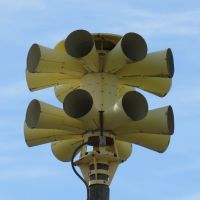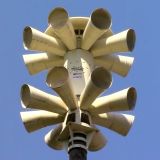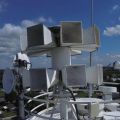20VXT
| Model 20V1T
Model 20V2T | |
 An older 3 ph Model 20V2T in Sandusky, MI. Photo taken by David S. (FAN DUDE) on 1/24/21 | |
| Company | Sentry Siren |
|---|---|
| Produced | 1980-present |
| Type | Omnidirectional Electromechanical |
| Sound output | 125 dB @ 100 ft (claimed) |
| Frequency | 60 Hz |
| Horsepower | 20 hp |
| Voltage | 208-230/460 V AC 1 or 3 ph |
| Preceded by | |
| Documentation | Product sheet |
Model 20V1/2T refers to 2 dual rotor electromechanical sirens produced by Sentry Siren, the dual-tone Model 20V1T and single-tone Model 20V2T. Essentially higher horsepower variants of the Model 15V2T, the Model 20V1T and Model 20V2T sirens are the 2nd highest horsepower siren that Sentry currently offers, only beaten by the Model 40V2T.
History
Following the success of the earlier Model 10V2T, the dual toned Model 20V2T was introduced as part of Sentry's 1980 lineup, alongside the Model 3V8, Model 5V and Model 10V. The Model 20V2T was the loudest, largest, and most powerful offering that Sentry had upon its release. It was also the most expensive. It would remain Sentry's loudest siren until the late 1990s, when the Model 40V2T was released. Like all of Sentry's mechanical sirens, it uses the rotor and stator from the Sterling Siren Fire Alarm Model M. Early production 20V2T units used square horns, instead of round ones; these were the earliest 20V1/2T units produced and were only made for a short time. Approximately 50 of these units were produced between 1980 and 1981, before it was decided that these were too difficult and expensive to produce. In 1981, the horns were changed to the round design used today. Very few of these units remain today, with the last active unit in Russiaville, IN being destroyed by lightning; another unit sits inactive in Washington, IN. In 2014, Sentry decided to make the Model 20V1T the standard option, with the Model 20V2T still being available through special order. This decision was likely made to make the siren stand out against the Model 15V2T, which was cheaper and selling better than the Model 20V2T. In addition, the siren's range was increased due to being single tone. Both Model 20V1T and Model 20V2T's sales have waned over the years, largely due to its competition with Sentry's other offerings. The 2 sirens are nearly matched in performance by Model 15V2T and outperformed by Model 16V1T-B, both of which use less power; the latter also runs on DC. The Model 15V2T is less expensive, while cities looking for a larger siren typically choose the Model 40V2T.
Design
Model 20V1T, Model 20V2T

The 20VXT shares the same design as the 16V1T-B and 15V2T, being a large dual rotor siren with 8 long horns attached to each stator port. Unlike the 10V2T, the 20VXT has equal length horns. The 20VXT comes stock with these horns, however the siren can be ordered with skirts instead of horns if the customer wants it. On older units, these horns are flat at the end, but later production 20VXT units use pointed horns to help keep debris out. The 20VXT comes standard in either 1 or 3 ph power. 3 ph units are powered by dual sided 20 hp AC motor, while 1 ph units are powered by two single sided 10 hp AC motors. Single phase units use a centrifugal regenerative brake which slows the rotor down rapidly when the rotor reaches a low enough rpm in order to recharge the motor's capacitor. The 20VXT was originally offered in 8/16 port dual tone as standard, being the 20V2T. The 8/8 port single tone 20V1T was available through special order. The 20VXT produced 125 dB at 100 ft according to Sentry.
Due to being a vertical omnidirectional siren, its design is quite simple and similar to Sentry's other sirens. The siren itself is held up by a 6-legged mount which is directly attached to the bottom stator, which has a cone on the bottom to project the sound from the intakes better. The motor (or motors, if it is a 1 ph model) is in the middle of the siren, between the two rotors. It is protected by a cylindrical motor cover with ventilation holes to protect the motor from the elements. Notably, due to single phase units using 2 motors, the motor cover is significantly taller than 3 ph units, which makes them easy to differentiate visually. The upper intake on the siren is protected by a large rain shield, that keeps debris and moisture out of the top rotor. An eyebolt is also included to make installation easier. Model 20V1T and Model 20V2T come with 16 horns, all of which are equal in length. Model 20V2T units always have the 8-port rotor located on the bottom and the 16-port rotor on top. Sound is projected from 2 ports on the 16-port rotor per horn. The horns and both intakes are protected by mesh screens to help keep debris out of the rotors.
Model 25V2T-SC
Another variant of the siren was specially produced for the Holcim cement plant in Portland, CO named the Model 25V2T-SC. This special unit was designed specifically to be completely airtight, with cement dust being unable to enter and damage the siren's bearings and electrical connections. Despite being named the Model 25V2T-SC, the siren is 8/8 port single tone which technically makes it a Model 25V1T-SC. The siren was powered by a 25 hp dual sided 3 ph AC motor and used skirts instead of horns to prevent dust buildup. This special unit remained in service alongside the unique Model 40V2T-SC until sometime between 2015 and 2021, when the sirens were removed. The whereabouts of these sirens are unknown.
Gallery
-
A Model 20V2T in Russiaville, IN with square horns. Photo taken by Andy G. (TheMainDrew) on 9/1/24
-
The Model 25V2T-SC as formerly pictured on Sentry's website; Sentry themselves recently mistook this siren for a Model 15V2T.

